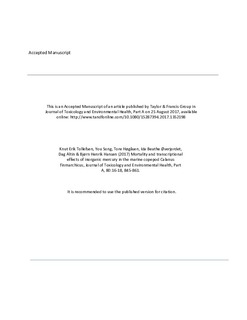| dc.contributor.author | Tollefsen, Knut Erik | |
| dc.contributor.author | Song, You | |
| dc.contributor.author | Høgåsen, Tore | |
| dc.contributor.author | Øverjordet, Ida Beathe | |
| dc.contributor.author | Altin, Dag | |
| dc.contributor.author | Hansen, Bjørn Henrik | |
| dc.date.accessioned | 2019-01-05T12:58:45Z | |
| dc.date.available | 2019-01-05T12:58:45Z | |
| dc.date.created | 2017-11-30T14:08:03Z | |
| dc.date.issued | 2017 | |
| dc.identifier.citation | Journal of Toxicology and Environmental Health, Part A. 2017, 80 (16-18), 845-861. | nb_NO |
| dc.identifier.issn | 1528-7394 | |
| dc.identifier.uri | http://hdl.handle.net/11250/2579328 | |
| dc.description.abstract | Inorganic mercury (Hg) is highly toxic to organisms including crustaceans and displays multiple toxic modes of action (MoA). The main aim of this investigation was to assess the acute and sublethal toxicity mediated by mercury chloride (HgCl2) in the marine copepod Calanus finmarchicus. A combination of short-term static studies to determine acute toxicity and a transcriptional investigation to characterize the sublethal MoA of HgCl2 were conducted with an in-house continuous culture of C. finmarchicus. Transcriptional changes were determined by a custom 6.6 k C. finmarchicus Agilent oligonucleotide microarray and quantitative RT-PCR analysis. Data demonstrate that HgCl2 produced a concentration- and time-dependent reduction in survival (NOEC48 h = 6.9 μg/L [Hg2+] and LC50 of 279, 73, 48, and 34 µg/L [Hg2+] after 24, 48, 72, and 96 h, respectively) and that exposure to sublethal concentrations of HgCl2 (5 μg/L [Hg2+]) induced differential expression of 98 features (probes) on the microarray. Gene ontology (GO) and toxicological pathway analyses suggested that the main MOA were (1) uncoupling of mitochondrial oxidative phosphorylation (OXPHOS) and ATP production, (2) oxidative stress and macromolecular damage, (3) inactivation of cellular enzymes, (4) induction of cellular apoptosis and autophagocytosis, (5) over-excitation of glutamate receptors (neurotoxicity), (6) disruption of calcium homeostasis and signaling, and (7) modulation of nuclear receptor activity involved in vitamin D receptor signaling. Quantitative RT-PCR analysis verified that oligoarray performed reliably in terms of specificity and response, thus demonstrating that Hg2+ exerts multiple potential MoA in C. finmarchicus. | nb_NO |
| dc.language.iso | eng | nb_NO |
| dc.publisher | Taylor & Francis | nb_NO |
| dc.title | Mortality and transcriptional effects of inorganic mercury in the marine copepod Calanus finmarchicus | nb_NO |
| dc.title.alternative | Mortality and transcriptional effects of inorganic mercury in the marine copepod Calanus finmarchicus | nb_NO |
| dc.type | Journal article | nb_NO |
| dc.type | Peer reviewed | nb_NO |
| dc.description.version | acceptedVersion | nb_NO |
| dc.source.pagenumber | 845-861 | nb_NO |
| dc.source.volume | 80 | nb_NO |
| dc.source.journal | Journal of Toxicology and Environmental Health, Part A | nb_NO |
| dc.source.issue | 16-18 | nb_NO |
| dc.identifier.doi | 10.1080/15287394.2017.1352198 | |
| dc.identifier.cristin | 1520976 | |
| dc.relation.project | Norges forskningsråd: 196711 | nb_NO |
| dc.relation.project | Norges forskningsråd: 223268 | nb_NO |
| dc.relation.project | Norges forskningsråd: 268294 | nb_NO |
| dc.description.localcode | This is an [Accepted Manuscript] of an article published by Taylor & Francis in [Journal of Toxicology and Environmental Health, Part A] on [25 Aug 2017], available at https://doi.org/10.1080/15287394.2017.1352198 | nb_NO |
| cristin.unitcode | 194,66,10,0 | |
| cristin.unitname | Institutt for biologi | |
| cristin.ispublished | true | |
| cristin.fulltext | postprint | |
| cristin.qualitycode | 1 | |
